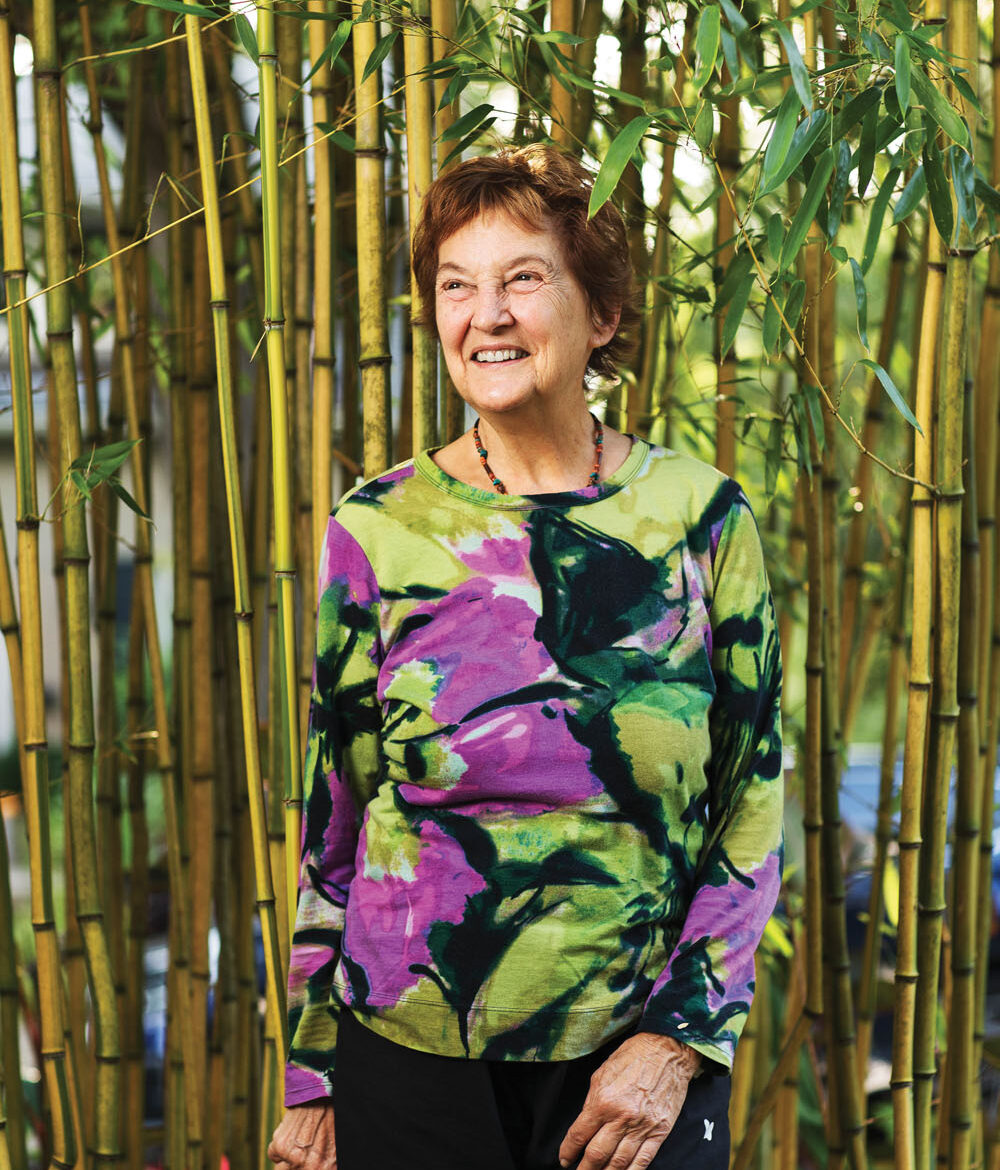
Carol Stangler has been cultivating her expertise since the 1980s. Portrait by Colby Rabon
Carol Stangler describes the medium she practiced for many years as environmental art: working with natural materials to make baskets and create sculptural pieces. To supplement that calling, she was an artist-in-residence in public schools in and around Atlanta, where she lived for nearly three decades.
It was there that she began “fooling around with bamboo,” an interest piqued when she was exploring a friend’s rural Georgia property and discovered a grove of the legendary plant, long associated with Asian countries but naturalized worldwide in warm climates. “I had never seen it in my entire life, growing up in Western New York,” she confesses. “I couldn’t find much written about it, so I said, ‘Well, let’s saw some down and see what we’ve got.’”
After she learned the tricks of working with bamboo, she enlisted community members to help create the framework of a 12-foot-in-diameter woven-vine sculpture, “Earth Ball Atlanta,” commissioned by the city for its 1990 Earth Day celebration. Soon after, she was awarded a grant from Georgia Council of the Arts to experiment with the use of bamboo as a new fine-craft material for the state’s artists.

Later, she visited the Bamboo Institute of Japan, and shortly after moving to Asheville in 1998, contracted with Lark Books to write The Craft & Art of Bamboo, published in 2001. “I was picked up by the American Bamboo Society, and went all over the country teaching.”
She was so busy she paid scant attention to the property around the nearly century-old bungalow she had purchased in Montford. “There was kind of a semi-garden out front, but so much privet I didn’t find the pond in the corner of the yard for nearly two years.”
As she began planning her property, bamboo became the dominant choice. She collected rhizomes — horizontal subterranean stems with roots that cling fiercely to the ground — from the conventions she attended, and a friend in Oregon gifted her with others. Bamboo is the fastest growing plant in the world, and Stangler acknowledges its bad reputation as a super-spreader if not correctly contained and cultivated. She quips: “We say the first year it sleeps, the second year it creeps, and the third year it leaps.”
Stangler has five varieties of bamboo in different areas of her property; the first one she planted, along the back of the lot, is the common regional variety, Phyllostachys aureosulcata: green, tall, and with an occasional zigzagging kink toward the base of the cane. From her bamboo connections in the Northwest, she obtained and planted two other varieties in the front yard: a bright yellow cane with green stripes and one with thin15-foot stalks bearing many branches and large, variegated leaves. In the side yard is a hedge of clumping bamboo — Fargesia rufa — that’s bushy and thick. The gardener is very fond of her black bamboo: Slender and green in its first year, it eventually turns chocolate to ebony.
Walking through the garden — which consumes the property, including a custom wisteria curtain on the house’s front porch and a ravine to one side — Stangler points out bamboo-wood objects she has made. A Japanese-style screen stands beside the now thriving pond, under a 100-year-old white-oak tree that was in poor health when she first encountered it.
“I called the tree whisperer [a local arborist], and he dug out all around the crown where soil had built up, drilled little holes in the trunk, put in mushrooms and other good stuff, and it’s beautiful now,” she explains. “The canopy is gorgeous.” A tall black-bamboo trellis leans against the exterior chimney, and a bamboo handrail ascends from her driveway to the edge of her neighbor’s yard. This summer, the property, dubbed the “Asian Fusion Garden,” was a featured stop on the Montford Garden Tour.
Stangler, who’s currently studying Ikebana — the Japanese art of flower arranging — has a screened basketry studio attached to the house where she keeps reed, tree bark, and sea grasses, plus honeysuckle vine she confesses she foraged from a pile cut down by the city in a lot across from the Orange Peel.
“I never leave home without my pruner,” says Stangler. “But really, most of the time I just garden. It’s my true treasure.”
